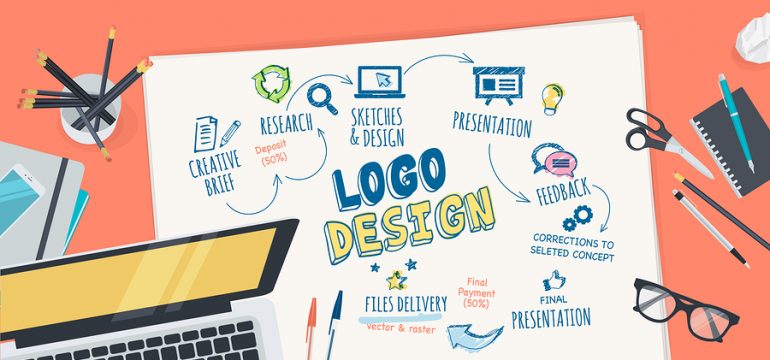As long as visual design has existed, there have been a few people willing to try passing off someone else’s work as their own. Logo theft may be more common today than ever before, in fact, thanks to the wide availability of images on the Internet. It might seem harmless enough to copy a logo owned by a company halfway across the world — unless that logo happens to be yours.
If two companies in the same area or industry have similar logos, the resulting confusion can damage one or both companies — and harm consumers who think they’re buying something they aren’t. That’s exactly why trademark law exists: it protects consumers from brand confusion and gives companies the ability to seek compensation when appropriate.
As in many areas of business, though, the best defense against logo theft is a good offense. By taking an active role before, during and after the development of your logo, you can design a logo that inherently resists plagiarism. If someone does decide to steal your logo, you can make the theft easy to detect and ensure that you have the power to enforce your legal rights.

Own All Logo Assets
When you set out to design a logo or have one designed for you, it’s important to protect your legal rights at every stage to prevent logo theft. If you’re using an outside designer, preventing logo theft begins with using the correct language in your contract. To avoid the possibility of another company’s logo looking like yours in the future, make sure that you’ll have full copyright ownership of the logo and all assets — such as icons and fonts — used in its creation.
Due Diligence
It is difficult to guarantee the complete originality of any design idea — especially with current trends that favor flat, abstract design. There are limited possible permutations of letters and symbols, and sometimes a designer can accidentally “copy” someone else’s work without ever having seen it. In fact, a recently unearthed design book from 1989 contains trademarked logos from the past that look eerily similar to the logos of well-known current brands such as Beats and Airbnb. The ubiquitous Bluetooth logo even appears in the book — which was published years before Bluetooth existed.
In most cases, it is your responsibility to ensure that your company’s logo doesn’t violate an existing trademark. However, it may be wise to ask your designer what method he or she uses to ensure that the logo you purchase won’t resemble something that already exists. Remember, though, that a thorough trademark search isn’t free. You’ll need to cover the designer’s cost of conducting a thorough search or conduct the search yourself after receiving the logo.
Legal Protection
Once your company has a logo, register it as a trademark with the U.S. Patent and Trademark office as well as the trademark office governing your state. The combined cost to register state and federal trademarks is usually under $400. However, hiring an attorney to conduct a search of existing trademarks and file the paperwork for you is often the best way to ensure the acceptance of your applications. An attorney may charge up to $2,000 for trademark registration assistance.
It’s possible that the cost of registering your company’s logo as a trademark will actually be higher than the cost of having the logo designed. However, it’s hard to place a value on the legal protection that a trademark provides. A trademark will naturally deter casual theft of your company’s logo, and if another company should ever use a logo similar to yours — accidentally or intentionally — you may have the right to seek compensation in court.
Work With One Designer or Firm
When it’s time to design a logo for your company, crowdsourcing may sound like an attractive option. Crowdsourced design websites give you the ability to specify the fee that you’d like to pay for your logo up front. Dozens of designers may submit their logo ideas, giving you potentially hundreds of logos from which to choose.
The problem with crowdsourcing your logo’s design is that, with many people submitting ideas for your consideration, no individual has a particularly good chance of receiving the reward. Designers are therefore unlikely to spend a great deal of time on crowdsourced projects. You may end up discovering that your logo includes assets reused from another project — or that the designer reuses aspects of your company’s logo for another project later.
Avoid Using Stock Images or Clip Art
Designing a logo yourself is an option that’s even less expensive than crowdsourcing. If you decide to go this route, avoid the temptation to use stock images or clip art. Clip art might be free for you to use, but the problem is that the same images are free for everyone else to use as well. You’ll have difficulty acquiring a trademark for a logo made from clip art, and it’s highly likely that you’ll find a similar logo in the future.
Conduct Reverse Image Searches
Reverse image search engines such as TinEye and Google have the ability to find images using visual data rather than text. Simply upload an image, and you’ll find out if similar images exist online. When you design a logo or have a designer create one for you, it’s a good idea to conduct a reverse image search to find out whether the logo could potentially violate an existing trademark.
Once you begin using your new logo, continued vigilance is important — not just because logo theft could cause material damage to your company, but also because failure to protect a trademark could result in its loss. Conduct reverse image searches routinely to spot attempts to steal your logo.
Use a Digital Watermark
By adding a digital watermark to your logo, you add information that makes the logo very easy to find with an online search. However, the watermark doesn’t alter the logo visually. A digital watermark can be an excellent way to deter logo theft, especially if your primary concern is that other companies might place your company’s logo on products or websites without authorization.
Companies use proprietary technology to add digital watermarks to images and other content, so shop around before you buy. You’ll want to confirm that the watermark you select is robust and will persist even if your logo is modified slightly. Many companies that specialize in digital watermarks will also search the Internet on your behalf to identify potential theft.
Get a Great Logo Today
Are you ready for a spectacular logo that will establish your brand and set the tone for years of future success? Contact Logo Design Team today. We have a pool of more than 120 professional designers, enabling us to put several people to work on each project simultaneously for incredibly quick turnaround times. Each artist will create a unique rendition of your logo. Select your favorite, and it’s yours.
Do you have a larger project in mind? Allow us to craft your company’s entire image from the ground up. In addition to your logo, we’ll design your stationery, business cards and product brochures. We’ll even create a design template for your company’s website — and our logo design service includes a money-back guarantee.
It’s time! Belive in something better. We are LogoDesignTeam, We do it right!
Get in touch today!






